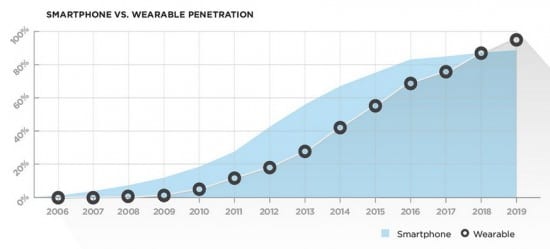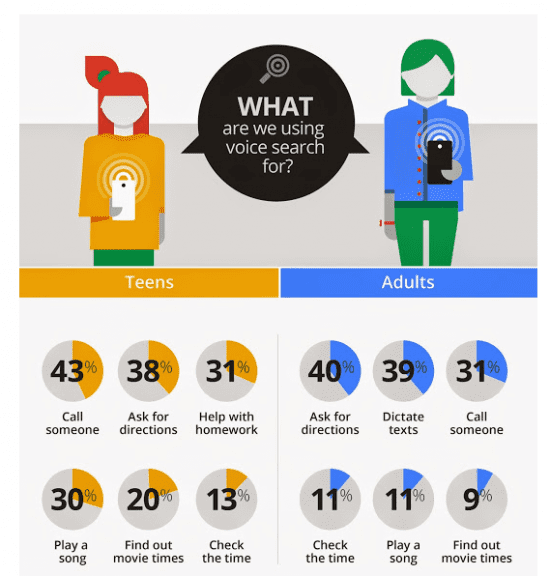Wearable technology trends and the future of digital selling
Until what seems like very recently, wearable technology has remained on the fringes of consumer consciousness, with most people unsure what to make of it. 'What’s the point in moving the user interface two inches from my pocket to my wrist?' people rightly ask. 'But I’m terrible at multitasking, those glasses will just be another distraction…' Although wearables still have yet to gain widespread popularity, interest is stirring and 2015 may just be the year it turns a corner.
According to a recent report from Juniper Research, wearable advertising spend is estimated to reach just $1.5 million this year, but by 2019 is expected to hit a slightly more impressive $68.7 million. That’s a huge new market, and one that online marketers would do well to embrace.
Source: Penna Powers
Three trends for the future or wearables
The evolution of the smartphone into wearable, multi-purpose tools will change the way we interact with each other and the outside world, which in turn will transform the consumer experience.
Here are three big changes that wearable tech is pushing forward:
- 1. One of the most valuable changes, from a user experience point-of-view, is the new hyper relevance of search results and ad targeting. As consumers use mobile devices more than desktop, companies will be able to see precisely what customers are looking for at all times and where, based on a combination of previous search history, current location, and the general pool of data gained from the wearable device itself.
- 2. Relatedly, voice search will continue to adapt and evolve, especially as wearables gain more widespread acceptance. Google Now on Android Wear, for example, can already answer queries in real time and provide updates on your local surroundings; all via some nice looking cards that are far easier on the eye than the traditional SERPs. Google’s Knowledge Graph/Vault is growing ever more sophisticated, to the extent that Google should soon be able to respond to all voice questions instantly (i.e. without users having to click through) and in full sentences.
- 3. Wearables are perhaps most valuable to the user when the data gained from the wearable experience is integrated more broadly into an interoperable retail ecosystem, which allows marketers and customer service teams to be in-touch with the shopper at every point along their journey. The result of this system is that users will no longer be tied down by a single device when it comes to search, but will be able to pick up precisely where they left off.
Customer personalisation and the emergence of ‘super data’
Being constantly attached to the wrist, the smartwatch allows for incredibly precise, granular data to be collected about the user. This is likely to radically impact the retail experience as hyper personalised offerings become commonplace.
Wearables will soon be able to collect and feed numerous ‘super data’ back to retailers – data such as a user’s in-store shopping frequency, their basket size, value per item, length of stay and common dwell times – meaning that online advertising placements and scheduling can become more acutely defined.
In addition to this, wearables will also grant access to more holistic personality traits about the customer, such as what you listen to, what you “like”, and what you tend to browse. With this data, retailers should be able to connect all the dots between pre-purchase research and in-store behaviour, reaching a new level of interconnected retail.
A recent Econsultancy report in association with ResponseTap found that despite technological advances in the past four years, marketers have made little-to-no progress in joining the dots across their customer’s journey. It seems the arrival of wearable devices, which will likely make omnichannel retailing much more simple and effective, couldn’t come sooner.
Based on the numerous clues provided by the wearable device, together with pinpoint geofencing, customers will be treated to perfectly timed, astutely relevant, and emotionally on-point messaging, which ties into their entire browsing and buying journey.
Google Now and its impact on SEO
Being ranked number one will become much more important with voice search as Google seeks to provide just a single answer, rather than a list of site pages. Therefore, when optimising for voice search, it makes sense to pick just one, or possible two, main keywords and focus on ranking top for those.
On-site
 For other voice search queries, which tend to be longer, more specific, and more conversational than traditional search terms, you'll need to begin focusing on long tail key phrases and conversational search queries.
For other voice search queries, which tend to be longer, more specific, and more conversational than traditional search terms, you'll need to begin focusing on long tail key phrases and conversational search queries.
One technique would be to create a well-optimised FAQ section on your site, which covers all the main questions a user might ask about your business. Search engines are now looking for websites that provide the best and most specific responses for users: help yourself, and Google, out by becoming the most relevant resource.
Off-site
In terms of your off-site efforts, start developing your content marketing strategy around commonly searched-for phrases, rather than single keywords. But be warned that, with voice search, this is likely to be much more challenging to identify these commonly searched for long tail phrases.
Ultimately the prominence of specific keyword optimisation is likely to fade with the emergence of wearables. Instead, marketers will need to learn the exact requirements of their users, and provide content that answers these questions in context.
Designing activity-based brand experiences
It is hoped that wearables will bring greater relevance to the consumer when it comes to their spending habits, however this ultimately relies on the way marketers and retailers handle the data that this new technology is able to collect.
Being a highly personalised engagement platform, wearables create opportunities for delivering advertising with much greater context and relevance to the user—solidifying the trend away from advertising as interruption, toward native advertising – however if brands want to create truly positive and memorable experiences via these new devices they will need to get smart with two things:
- Personal data, i.e. using insights from a much wider data pool, whilst respecting customer privacy on a whole new level;
- Leveraging things that customers already use and like to get their brand message across in physically creative ways.
Since wearables essentially turn advertising into a form of activity-based engagement, brands will need to think about how to actively engage their users, rather than simply relaying generic brand messages.




 For other voice search queries, which tend to be longer, more specific, and more conversational than traditional search terms, you'll need to begin focusing on
For other voice search queries, which tend to be longer, more specific, and more conversational than traditional search terms, you'll need to begin focusing on 



